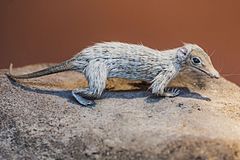Megazostrodon
Megazostrodon is an early proto-mammal, discovered in Lesotho, southern Africa.[2][3]
| Megazostrodon Temporal range: Hettangian,
| |
|---|---|

| |
| Megazostrodon model, Natural History Museum, London | |
| Scientific classification | |
| Domain: | Eukaryota |
| Kingdom: | Animalia |
| Phylum: | Chordata |
| Clade: | Synapsida |
| Clade: | Therapsida |
| Clade: | Cynodontia |
| Family: | †Megazostrodontidae |
| Genus: | †Megazostrodon Crompton & Jenkins, 1968[1] |
| Type species | |
| Megazostrodon rudnerae Crompton & Jenkins, 1968[1]
| |
It is one of the first mammals, and appeared in the fossil record about 200/205 million years ago (mya).[4] It did have some non-mammalian characteristics,[5] but overall this animal, and Morganucodon, probably show the final stage of the transition between the cynodonts and true mammals.[6]
Characteristics
changeIt is thought that the animal was nocturnal as it had a relatively much larger brain than its cynodont relatives,[4] and the enlarged areas of its brain were found to be those which process sounds and smells.
Nocturnal activity in an animal of this size virtually requires an increased internal production of heat.[7]p124 From their size and teeth, Megastrozodon were probably insectivores, as were all its relatives at the time.[8]p300 Their small size suggests some kind of temperature regulation, which in turn suggests insulation in the form of fur.
The night-time behaviour and insectivorous habits gave these early mammals a niche which did not compete with the reptiles.[9]
These early mammals developed many traits which made them well-suited for an active lifestyle. They developed four types of teeth.[10] There is evidence that the inward-closing movement of the mandible suggests a shearing action to chew food.[11] Their skeletons changed so that their limbs were more flexible (they became less laterally splayed,[12] allowing for faster forward motion) and they developed a shorter ribcage and larger lungs[10] to allow for faster respiration. The structure of their jaw bones changed, the lower jaw becoming a single bone — the dentary. The other bones which once made up the jaw moved to the middle ear to create a hearing system.[4]
References
change- ↑ 1.0 1.1 Crompton; Jenkins (1968). "Molar occlusion in late Triassic mammals". Biological Reviews. 43 (4): 427–458. doi:10.1111/j.1469-185x.1968.tb00966.x. PMID 4886687. S2CID 1044399.
- ↑ "Dinosaur Mailing List". Archived from the original on 2011-11-15. Retrieved 2014-05-13.
- ↑ Crompton and Jenkins, "Molar occlusion in late Triassic mammals", Biological Review, 43 1968:427-458.
- ↑ 4.0 4.1 4.2 Fur and Fangs: Mammal Origins Archived 2011-06-05 at the Wayback Machine. Palaeobiology and Biodiversity Research Group, University of Bristol.
- ↑ the evolution of the ear ossicles had not reached its modern state
- ↑ "Historical Biology. 1992, vol. 6 p.186" (PDF). Archived from the original (PDF) on 2007-09-30. Retrieved 2014-05-13.
- ↑ Kemp T.S. 2005. The origin and evolution of mammals. Oxford University Press. ISBN 0-19-850760-7
- ↑ Benton, Michael J. 2005. Vertebrate paleontology. 3rd ed, Oxford: Blackwell. ISBN 0-632-05637-1
- ↑ Smithsonian Science Abstract
- ↑ 10.0 10.1 First Mammals Appear
- ↑ Savage R.J.G. and Long M.R. (1986). Mammal evolution: an illustrated guide. Facts On File Inc. p. 41. ISBN 0-8160-1194-X.
- ↑ Mammalian Characteristics. Sam Houston State University.